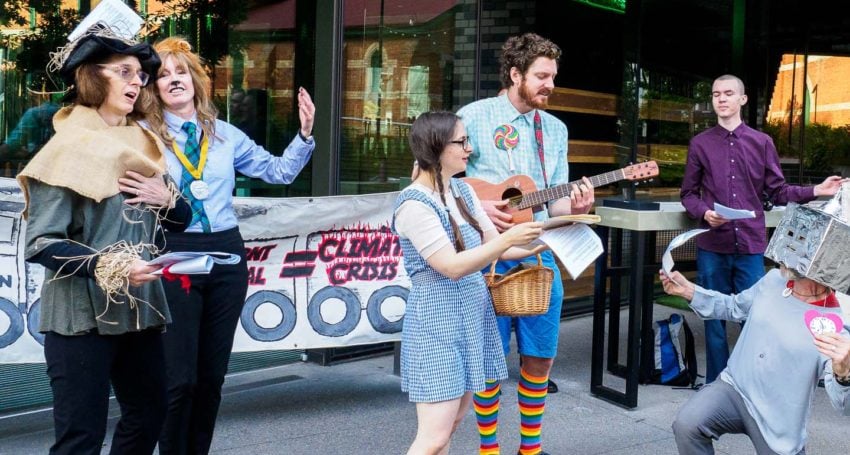Sowing seeds of change in the footsteps of courageous Christians
Features
“As people of faith and in the tradition of other Christians who have engaged nonviolent approaches, we know that positive change is possible and we seek out the most measured, strategic and effective ways to communicate our message,” says St Andrew’s, South Brisbane parishioner Oscar Delaney

Story Timeline
Christian nonviolent engagement
I have been keenly interested in history since I was a young child. In my reading, the role of peaceful protest and civil resistance particularly interested me, so whenever I got the chance at school, I would research these topics. In our unit on the Israel-Palestine conflict I wrote about the role of nonviolent activists in the peacebuilding and anti-occupation movements. When studying the United States I, of course, researched The Rev’d Dr Martin Luther King Jnr and other Christians’ successful efforts to radically transform a deeply racist society and achieve civil rights for African Americans. When studying Nazi Germany, I chose to write about the role of the Church in undermining, but sadly more often than not supporting, the Third Reich, and was particularly impressed with Lutheran theologian and pastor Martin Niemöller, who was imprisoned for his resistance and narrowly escaped execution. Niemöller is best known for his poem, ‘First they came’:
Advertisement
“First they came for the Communists
And I did not speak out
Because I was not a Communist
Then they came for the Socialists
And I did not speak out
Because I was not a Socialist
Then they came for the trade unionists
And I did not speak out
Because I was not a trade unionist
Then they came for the Jews
And I did not speak out
Because I was not a Jew
Then they came for me
And there was no one left
To speak out for me”
Even before my more formal studies of Christian nonviolent activists, though, I remember often hearing about Saint Telemachus as a younger child because my dad loves to tell the story. A humble Christian monk, Telemachus was drawn with the crowds into a Roman amphitheatre (possibly the Colosseum, but it is not known for sure) and was shocked to see people fighting to the death for the amusement of the masses. In a brilliant act of God-led courage, he entered the arena himself, imploring the gladiators to lay down their arms and for the crowd to leave. He was soon killed. Remarkably, his simple nonviolent protest against brutality marked the end of gladiatorial battles in Rome. Telemachus’ story is a wonderful historical example of how the power of one person acting boldly and peacefully at the right time can bring about enormous change.
Advertisement
While I expect not to be killed for peaceful protesting or civil resistance, as King and Telemachus were, or spend years in jail, as Niemöller did, I am inspired to follow in their footsteps by taking measured steps to campaign for peace and justice today. While I have joined protests against the indefinite detention of refugees, much of my activism focuses on damage to the climate, as I see it as the most pressing current challenge for humanity. Most of my efforts in this space are through traditional institutional means – writing to elected representatives about the bushfires, coal and climate; making submissions to parliamentary enquiries like the recent one into using taxpayer money to fund gas projects; and, helping challenge Clive Palmer’s proposed coal mine on human rights grounds in the Land Court. Sometimes, though, I follow in the rich tradition of peaceful Christian activists by directly protesting at fossil fuel companies’ offices.
Most recently, I became part of a new group, Faith in Climate Action, appealing to rail company Aurizon to reduce their haulage of thermal coal. As well as some lovely liturgies and prayers, the dozen or so of us acted out an extended street theatre piece based on The Wizard of Oz. We implored Aurizon to have a heart and care about the people who are being displaced because of damage to the climate and impacted by extreme weather events; to have the courage to engage with new business models and reimagine a clean energy future; and, to have the brain to map out this transition. As well as The Wizard of Oz’s characters being apt metaphors, we felt some creativity would effectively convey the message more effectively than traditional speeches.
Related Story
 Features
Features
Slumdog takes on millionaire
Encouragingly, as a result of our protest at Aurizon, representatives of our group were invited to meet with two senior Aurizon staff members. While this was a great indication that our protest grabbed the attention of Aurizon managers, the meeting cemented our concerns that Aurizon is currently committed to hauling coal over the coming decades. It is hoped that social media coverage of this action, together with coverage of other protests and the efforts of others as they appeal to their own elected representatives and companies like Aurizon, will help to create the clean energy shift needed to keep our communities healthy and safe.
As people of faith and in the tradition of other Christians who have engaged nonviolent approaches, we know that positive change is possible and we seek out the most measured, strategic and effective ways to communicate our message. Our reasoning goes like this: damage to the climate is an urgent global issue; coal damages the climate and is the most polluting fuel; Australia is currently the largest exporter of coal; Aurizon is the biggest hauler of coal in Australia, and is, therefore, a logical focus.
I continue to be inspired by Jesus’ message of peace and by courageous Christians through the centuries who have used nonviolent approaches for a just cause.
Through your own studies and reflection maybe you, too, are motivated to sow seeds of change, be it by writing to your elected representatives, creating petitions, campaigning or peacefully protesting.
Top 10 tips for effectively planned and messaged vigils and nonviolent Christian actions and engagement
- Plan activities well and factor in contingencies: be (and look) organised so activities go smoothly and, as part of the planning, consider what to do in various circumstances, such as if the weather is wet or a passerby becomes unruly, etc.
- Designate roles and tasks: ensure key roles and tasks are delegated to appropriately experienced people, including engagement with building managers, security staff and passersby; media liaison and media spokespersons; photography and videography; social media; and, running of the liturgy and prayers.
- Be strategic with your messaging: ensure that your message (in speeches, signage, social media and media alerts/releases, etc) is clear, positively framed, solutions-focused, jargon free, respectful, consistent and tailored for your audience, and avoid the trap of using language that merely ‘preaches to the choir’.
- Have clear and achievable ‘asks’: ensure that what you are asking is easily understood, concise and achievable; for example, make sure that any ‘asks’ of elected representatives fall within their remit and level-of-government jurisdiction.
- Be positive and hopeful: people can get disheartened by serious and complex issues, so it is a good idea to share positive news as well, such as local examples illustrating how constructive change is happening.
- Be creative: many passersby have already seen a few protests and often aren’t that interested in stopping to watch and listen, but if the action is vibrant, colourful and unique, it is more appealing and engaging.
- Be responsible and strategic about the location: ensure that the place of your action is relevant to the issue and ‘asks’; for example, if you wish to hold a vigil or protest to advocate for refugee rights, then consider holding the peaceful action outside a detention centre or relevant Federal Government office.
- Be respectful and kind at all times: regardless of where we may disagree with others (such as passersby), it is important to witness Christ by always being respectful, kind and empathetic.
- Ensure safety: make sure that all activities keep people involved and passersby safe; for example, appoint a person to politely ‘marshal’ participants away from kerbs, pack a first aid kit, encourage people to bring water so they stay hydrated, and ensure that activities do not cause traffic mayhem.
- Liaise with media before and after: send the media a very brief summary via a ‘media alert’ before the activity with the what/where/when/why details and the contact information of media spokespersons. After the event, send the media a press release (preferably within 24 hours of the event), along with three to four quality, high-resolution landscape-orientation images (and image captions) and the contact details of media spokespersons.





